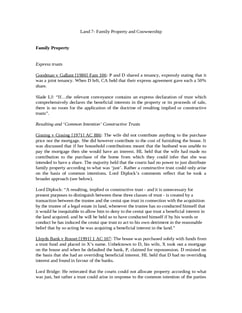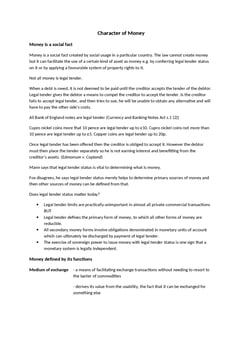Lloyds Bank plc v Rosset [1989] Ch 350
Judgement for the case Lloyds Bank plc v Rosset
Table Of Contents
Defendant 1 and Defendant 2 bought a semi-derelict house in only Defendant 1’s name. A family trust fund paid for Defendant 1’s house. Defendant 1 took out a mortgage from Plaintiff without telling Defendant 2. Defendant 2 made no financial contribution.
Defendant 1 deserted Defendant 2 and, failing payments, Plaintiff sought possession of the house.
CA found for Defendant 2, saying that a semi-derelict house IS capable of actual occupation and that the constant presence of Defendant 2’s agents (in this case builders) = actual occupation. Builders were as much Defendant 2’s agents as Defendant 1’s.
CA held that the relevant date for determining whether overriding interest/disposition has priority is the date of execution, NOT of registration. Here, Defendant 1 mortgaged to Plaintiff AFTER the overriding interest had been executed i.e. actual occupation had begun, and therefore Plaintiff’s mortgage was subject to OI.
Nicholls LJ
The everyday meaning given to “actual occupation” by Wilberforce in Williams’ and Glyn’s Bank extends to occupying incomplete houses. I can occupy without “inhabiting”, and this extends to agents e.g. residential caretaker.
Mustill LJ (dissenting)
Nicholls LJ is pushing the ordinary meaning of “actual occupation” too far.
RELATED CASES
For Further Study on Lloyds Bank plc v Rosset

Land Law notes fully updated for recent exams at Oxford and Cambridge. ...
Need instant answers? Our AI exam tutor is here to help.
Ask questions 🙋 Get answers 📔 It's simple 👁️👄👁️
Our AI is educated by the highest scoring students across all subjects and schools. Join hundreds of your peers today.
Get StartedSimilar Cases
Related Product Samples
These product samples contain the same concepts we cover in this case.
| Personal Property Law | Destruction Of Property Rights Notes (24 pages) |
| Land Law | Registration Theory Notes (39 pages) |

 Since 2010, Oxbridge Notes has been a trusted education marketplace, supplying high-quality materials from top achievers at universities like Oxford, Cambridge, LSE, Harvard, and Yale.
Since 2010, Oxbridge Notes has been a trusted education marketplace, supplying high-quality materials from top achievers at universities like Oxford, Cambridge, LSE, Harvard, and Yale.